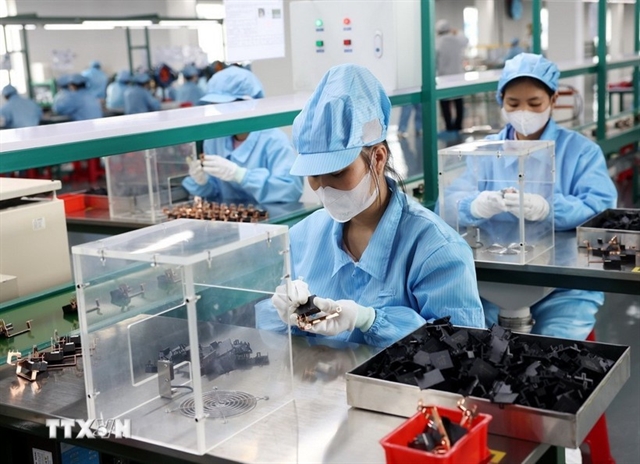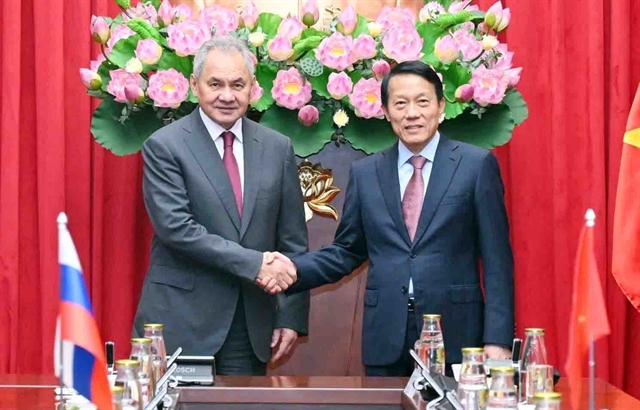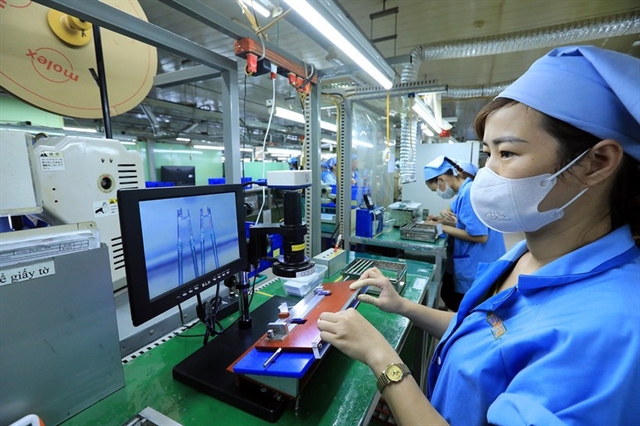 Opinion
Opinion

Trần Chí Thành, President of the Vietnam Atomic Energy Institute under the Ministry of Science and Technology, spoke to Việt Nam News about the proposal of developing nuclear power over the coming decades to ensure national energy security and meet the ‘net zero emission’ goal.
The Economic Committee of the National Assembly (NA) has recently proposed developing nuclear power over the coming decades to ensure national energy security and meet the ‘net zero’ goal Việt Nam set at the 26th UN Conference on Climate Change (COP26). Trần Chí Thành, President of the Vietnam Atomic Energy Institute under the Ministry of Science and Technology, spoke to Việt Nam News about the issue.

|
| Trần Chí Thành, President of the Vietnam Atomic Energy Institute. Photo vietnamhoinhap.vn |
You were one of the key people involved in the plan for nuclear power plants in Ninh Thuận, which was approved by the National Assembly in 2009. However, the plan was put on hold in 2016 in order to mobilise resources for other key projects. The NA has recently proposed bringing back the project. In your opinion, why is it necessary for Việt Nam to restart the programme?
The nuclear power development programme was actually initiated in the 1970s, but it was not until 1996-2009 that this type of energy was seriously studied, after the country’s leaders approved the policy, with the goal of ensuring national energy security as Việt Nam has high demand for economic growth.
The proposal on the investment policy for the nuclear power plants in Ninh Thuận Province was submitted to the National Assembly by the Government at the end of 2009, suggesting the construction of two plants: Ninh Thuận 1 and Ninh Thuận 2 in Thuận Nam and Ninh Hải districts, with total capacity of 4,000 MW. The initial investment was expected to be VNĐ200 trillion (nearly US$9 billion).
A series of investment and infrastructure preparation activities was carried out by the Government, ministries, sectors and localities, and EVN in the following years, such as the Feasibility Study (FS) and Site Approval Dossier (SAD) for Ninh Thuận 1 and Ninh Thuận 2 NPP projects, starting from 2011, and supplemental projects like the Ninh Thuận coastal route, and restarting the Tân Mỹ Lake.
The Vietnam Atomic Energy Institute (Vinatom), the major national research institute in the field of atomic energy, was assigned to prepare a source of technical experts to do research on technology and nuclear power safety for the national nuclear power programme. Nearly 100 people were sent abroad to study masters and doctoral programmes in the Russian Federation, Japan, South Korea, Europe and America.
In addition to this group, there were about 450 graduate students and engineers sent to study in Russia and Japan under the training program of the Ministry of Education and Training and specialised training of the Electricity of Việt Nam (EVN), including university training in nuclear power, technologies and safety of nuclear power plants.
After seven years of preparation, in November 2016, the National Assembly decided to cancel the two Ninh Thuận nuclear power plants project. At that time, the Government said that it was not due to technology and safety issues, but Việt Nam's macroeconomic development conditions had many changes and needed a large capital source to invest in infrastructure and key projects to create a driving force for socio-economic development.
As a person who participated in the programme since its beginning, of course I was disappointed and felt sorry that we couldn’t continue at that time. We had gone so far and made many preparations, both in terms of legal foundations as well as in terms of technologies and human resources.
I think it is necessary to resume the plan on nuclear power development as soon as possible, as the NA Economic Committee has proposed. From the perspective of medium and long term national energy security, it is necessary to consider all possible scenarios for nuclear power generation in the power master plan of the country. This is a large, stable, and reliable power source to run in the background of the electricity system, which does not create greenhouse gases and is easy for supply and storing of fuel.

|
At the COP26 global conference in November 2021, most countries committed to balance CO2 emissions by 2050/2060, by transforming the electricity structure. Specifically, they will gradually phase out coal-fired power, reduce gas and liquefied petroleum gas (LNG), thermal power, and promote the development of renewable energy. The view that nuclear power is a source of electricity that does not emit CO2 is considered by many countries: It can play an important role in the structure of power sources.
In addition, the Ukraine crisis has pushed up oil and gas prices, especially gas prices, and shows that energy security becomes more important than ever. The United States and Western countries are eliminating, or gradually reducing, the dependence on oil and gas of the Russian Federation. To achieve this goal, nuclear energy is said to play a very important role.
How about human resources for nuclear power development? It’s been six years since the project was halted, will they be able to come back and still able to work on the new plan, if any?
Of the 450 students and engineers sent abroad to study nuclear power before 2016, many have returned to Việt Nam and worked for EVN. They might have switched to working in thermal power, hydroelectricity and power management projects. I’m sure they’ll be happy to contribute if the programme on developing nuclear power in Việt Nam is restarted.
VINATOM currently maintains international cooperation with countries such as Russia, Japan, etc. and the International Atomic Energy Agency (IAEA) on nuclear technology and safety through nuclear safety research projects, exchange of experts and design of new nuclear research reactors.
Although the project in Ninh Thuận was suspended, our institute continues to pursue research, and prepare human resources to be ready for nuclear power development.
However, it’s necessary that we restart the programme again soon or else we’ll lose all the experts that we have trained. Human Resources are the key to the success of the nuclear power programme. Nuclear power projects take a long time to be completed, and training people for nuclear power plants takes even longer.
Many people are still worried about the safety of nuclear power plants. What would you say?
By the end of March 2022, there were 441 nuclear power reactors in operation worldwide, with a total capacity of 394,000 MWe. There are 51 reactors under construction with a total capacity of about 54,000 MWe. Nuclear power still plays an important role in the power structure of many countries (32 countries have nuclear power), and the trend is continuing to develop. According to Director General of the International Atomic Energy Agency (IAEA) Rafael Grossi, in the next 10 years, about 10 more countries will develop nuclear power.
The US currently has the largest number of nuclear reactors in the world, 93 are operating with a total capacity of about 96,000 MWe, contributing about 20 per cent of this country’s power demand. France has 56 operating furnaces with a total capacity of 62,000 MWe, accounting for about 75 per cent of the national electricity production. China currently has 54 furnaces in operation, with a total capacity of more than 54,000 MWe. Since the Fukushima incident in 2011, Japan has restarted and is currently operating 10 nuclear reactors, and continues to restart other reactors.
Safety is of course the most important issue in nuclear power development. After nearly 70 years of development, with certain ups and downs related to incidents, up to now, the advanced generation III+ light water reactor (LWR) nuclear power technology has been very different from the initial period (reactors of generation I and II).
The current new generation design reactors all meet the latest stringent safety requirements (introduced after the 2011 Fukushima nuclear power plant accident in Japan). Currently, developed countries still maintain and develop nuclear power by continuing to operate existing reactors, prolonging operating time, and building new advanced Generation III+ light water reactors (LWRs), along with the development of a Small Modular Reactors (SMR) after the technology was commercialised and verified.
Currently, nuclear power safety can be guaranteed because of the following grounds: the nuclear regulatory system has always been consolidated and perfected; nuclear power design has accumulated great experiences through its history of development, ensuring all safety principles; and the standards and regulations applied to nuclear power are very high. Equipment production and manufacturing, as well as the process of building and installing the factory, are conducted methodically, closely monitored, and apply the most advanced technologies in project management. Human resources for operation and management are highly qualified. Lastly, all nuclear power projects are required to have technical support systems to ensure safety.
The new generation of nuclear power will mainly rely on advanced Light Water Reactors technology of generation III+ or SMR, depending on the conditions of each country. New technology ensures a high level of safety, without affecting people and the environment even in the event of an incident (if it happens, although the probability is extremely low).
What would you say about incidents in Chernobyl and Fukushima, and also about nuclear waste?
What happened in Chernobyl is actually due to design flaws and the overriding of safety protocols, what happened in Fukushima is because the sea wall at Fukushima-Daiichi was too low for the incoming tsunami wave. But Fukushima caused zero deaths and almost no measurable personal injury from radiation. With today's safety regulations and technology, none such incidents would happen.
For hundreds of nuclear reactors across the globe, waste has been stored at the site of the plant in a deep pool of water (for about ten years) or in “dry casks.” It should be noted that there have been no deaths, no injuries, and no social disruptions caused by radiation leakage of any kind.
Nuclear skeptics have observed that this is not a “permanent” solution because the waste remains radioactive a very long time (hundreds or thousands years). This is true. It is also true that radioactivity of spent nuclear fuel (SNF) drops continuously, making it, like all nuclear waste, less dangerous over time. There are radioactive isotopes that decay first, and give off quite a bit of radiation and heat. Some others dominate as radiation sources in the next phase, but after 300 years they are pretty much gone, too. So as long as we have a place to keep this waste safe, it will be fine.
The next question is where can the waste go? All of the nuclear waste ever created by American reactors could fit in a container the size of the football field and about two stories high. The whole world? A few football fields. Because nuclear power uses small volume of fuel, it succeeds well in containing all its waste.
So I think it is time to change the narrative on nuclear energy to support our ecosystem and our demands for energy.
So if Việt Nam is to return to its nuclear power plan, what would we have to do to make sure it’s effective and safe for the people, and the environment?
Việt Nam has actually made remarkable results in the preparation for the nuclear power programme: we have site planning, we already have a nuclear regulatory system. We have prepared and trained human resources for nuclear power and a project management board under the EVN. We have also researched, evaluated and selected the Generation III+ Light Water Reactors technology (VVER/ AES2006 for Ninh Thuận 1 and preferrable AP1000 for Ninh Thuận 2). And last, but not least, we have been maintaining close cooperation with countries that already have high-level nuclear power technology.
Therefore, the return to the nuclear power plan will be more rational and favourable if it continues what has been done before 2016.
If Việt Nam wants to consider restarting the nuclear power programme, a number of points should be paid attention to.
First, it is necessary to start from the nuclear power development programme on the basis of advanced light water reactors (LWRs), generation III+, because this is a mature technology, which has accumulated many scientific bases and experiences over the past 70 years. It would not make sense to restart the nuclear power program from the SMR, especially if the SMR is not yet commercialised, and unproven.
Second, the preparation to develop nuclear power is a long process, it takes 15-20 years, so it is necessary to have an early decision, or guidelines from high-ranking leaders so we can soon be able to gather human resources and what we have achieved before 2016.
Third, it is necessary to carefully consider and select suitable partners to implement nuclear power projects, consolidating and improving the scientific potential and geopolitical position of the country. At the same time, it is necessary to keep the sites for building the planned nuclear power plants, especially it is indispensable to keep two sites in Ninh Thuận Province.
Fourth, we also need to review and restructure the steering system and agencies participating in the nuclear power programme (if restarted), in line with international practices.
Fifth, It is necessary to focus on rebuilding and perfecting the nuclear regulatory system. First of all, the adjustment of the Law on Atomic Energy, with focus on improving and completing the contents related to nuclear power development.
Sixth, it is necessary to build a strong nuclear research and development (R&D) system (for technical support), with an emphasis on technology and nuclear power safety. In particular, it is necessary to build a strong team of specialists, train a team of good experts in nuclear power and safety, with specific mechanisms to encourage talented and dedicated people to enter the nuclear industry. At the same time, there should be a mechanism to attract a team of nuclear experts from abroad to come back to Việt Nam and invite international experts to participate in this nuclear programme. — VNS




